Naxi has been written with three different scripts:
Dongba script

The Naxi Dongba script (a.k.a. Tomba or dto-mba) was reputedly
invented by King Moubao Azong in the 13th century. It is used exclusively
by the Dongba (shamans/priests) as an aid to the recitation of
ritual texts during religious ceremonies and shamanistic rituals.
Use of the Naxi language and script was discouraged after the Communist victory in 1949, and they were actively suppressed during the Cultural Revolution in the 60s when thousands of manuscripts were destroyed.
Today there are about 60 Dongba priests who can read and write the Dongba script. Most are over 70, though at least three are under 30. In an effort to revive the script, the younger Dongbas frequently visit local schools in the Lijiang region to teach classes on it.
A newspaper was published during the 1980s printed in the Dongba script and the Latin alphabet in an attempt to increase the level of literacy among the Naxi people in their own language. Over 30 books were also published. There efforts were successful at first - in 1982, 200 people could read Naxi in the Latin alphabet. By 1985, 1,700 could do so. The Chinese government phased out Naxi language teaching in the late 80s, but recently effort have been made to start teaching the language again.
The script is also used on road signs and shop names in Lijiang.
Notable features
- Consists of about 1,400 symbols, 90% of which are pictograms, though some are also used for their phonetic values in accordance with the rebus principle.
- Due to its complexity, it can take over 15 years to become proficient in the Dongba script.
Sample of the Naxi Dongba script

Geba script
The Geba script is structurally similar to Chinese and contains a mixture of symbols derived from Chinese characters, independently invented symbols and simplified pictographs taken from the Dongba script. Few examples of texts in the Geba script are known, so the script is little understood.Notable features
- Written in horizontal lines running from left to right.
- The phonetic values of Geba symbols are not fixed, instead each user (usually a dongba, or priest) tends to prefer one set of readings over another, and symbols can have various phonetic values, or one phonetic value can be signified by a number of different graphs.
Part of the Naxi Geba syllabary

Sample Naxi text in the Geba script

Latin alphabet for Naxi
A version of the Latin alphabet based on Pinyin was introduced to write Naxi in 1957 and revised in 1984.Sample of Naxi in the Latin alphabet
Naqxi tei'ee jju pil gguf, Naqxi balzhee tv ceeq sie. Naqxi tei'ee Naqxi bal, sseiweq leq gee dde bbaq leq bbaq ssi ddee ddoq nee, Naqxi xiyuq huahuaq.Translation
Since the Naxi people have their own script, they publish a Naxi newspaper. The Naxi script newspaper is as beautiful as a blooming flower. Seeing this beautiful flower, we know that the life of the Naxi people will be joyful.
Links
Naxi Script Resource Centrehttp://www.sinoglot.com/naxi/
The Naxi Script Copybook (PDF, 1.43MB)
http://www.sinoglot.com/naxi/wp-content/uploads/2009/11/copybook.pdf
Articles about the Naxi Dongba script
http://www.wiedenhof.nl/ul/chtk/nieuws/dongba/
http://www.loc.gov/loc/lcib/9906/naxi1.html
edongba - software for typing the Naxi Dongba script
http://www.naxidongba.com
Naxi dongba fonts
http://www.efword.com/tompa/font/
Naxi Manuscript Collection in The Library of Congress
http://international.loc.gov/intldl/naxihtml/naxihome.html
Information about the Naxi people
http://www.china.org.cn/e-groups/shaoshu/shao-2-naxi.htm
http://en.wikipedia.org/wiki/Naxi
Information about and photos of Lijiang
http://www.terragalleria.com/asia/china/lijiang/lijiang.html http://www.globaltravelwriters.com/Galleries/Lijiang/
No comments:
Post a Comment
Note: Only a member of this blog may post a comment.